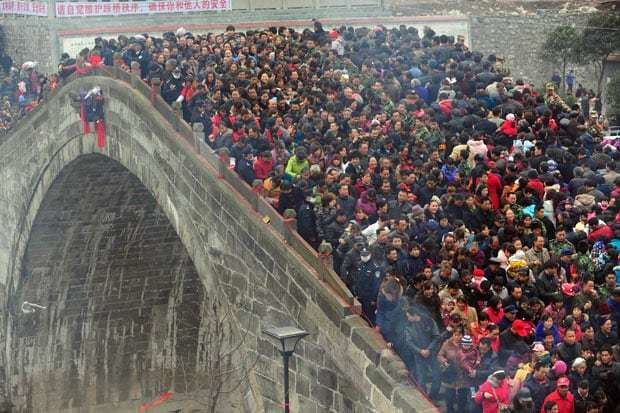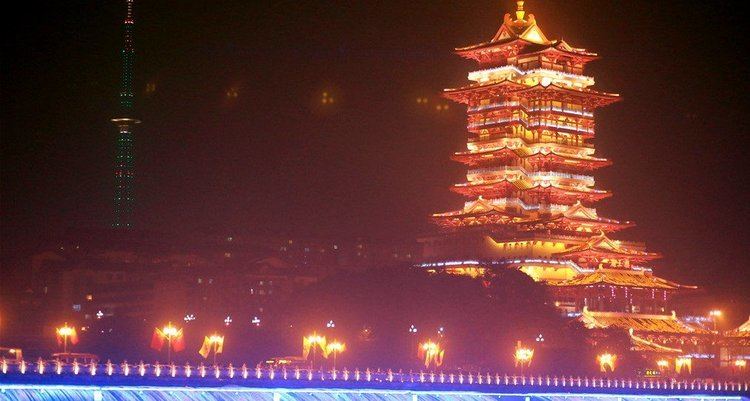Country Peoples Republic of China Population 1.163 million (2000) Area 20,267.46 km2 | ||
Mianyang (simplified Chinese: ; traditional Chinese: ; pinyin: ) is the second largest prefecture-level city of Sichuan province in Southwest China. Its population was 4,613,871 at the 2010 census covering an area of 20,267.46 square kilometres (7,825.31 sq mi) consisting of Jiangyou, a county-level city, six counties and two urban districts. Its built-up (or metro) area was home to 1,722,133 inhabitants including the city proper of Mianyang (two urban districts) and An County largely being conurbated as urbanisation sprawls. In 2006, Mianyang was ranked as Chinas third "most suitable city for living" by China Daily, after coastal cities Dalian and Xiamen.
Contents
Map of Mianyang
Daytime mianyang china
History

Mianyang, called Fuxian (Fu County) in ancient times, had advanced in agriculture during the Qin (221?206 BCE) and Han (206 BCE?220 CE) dynasties. It has a history of over 2,200 years since the Emperor Gaozu of Han established the first county in this area in 201 BCE. Due to its advantageous location, it had always been a town of great military importance and formed a natural defence for Chengdu.

Mianyang is home to the CAEP and Science City, an immense Military Research Complex which was the site of the development of China first nuclear bomb.
The city proper itself was only lightly damaged by the earthquake of 12 May 2008. However, Beichuan County, which is in the prefecture is among the most severely hit of all disaster regions following the earthquake, including the Beichuan High School campus, where more than 1,000 students lost their lives after two main buildings collapsed. Around 80% of the countys buildings are said to have collapsed, including its main government building. The casualty toll for the quake in Mianyang Prefecture as of 7 June 2008 was 21,963 people killed, 167,742 injured, and 8,744 people missing.
Geography and climate

Mianyang is at the northwestern end of the Sichuan Basin, on the upper to middle reaches of the Fu River. Its administrative area ranges in latitude from 30° 42 to 33° 03 N and in longitude from 103° 45 to 105° 43 E. Bordering prefectures are Guangyuan to the northeast, Nanchong to the east, Suining to the south, Deyang to the southwest, Ngawa Tibetan and Qiang Autonomous Prefecture to the west. It also borders Gansu for a small section in the north.

Mianyang has a monsoon-influenced humid subtropical climate (Koppen Cwa) and is largely mild and humid, with four distinct seasons. Winter is short, mild, and foggy, though precipitation is low. January averages 5.3 °C (41.5 °F), and while frost may occur, snow is rare. Summers are long, hot and humid, with highs often exceeding 30 °C (86 °F). The daily average in July, the warmest month, is 25.7 °C (78.3 °F). Rainfall is light in winter and can be heavy in summer, and more than 70% of the annual total occurs from May to September. The annual frost-free period across most of the prefecture lasts from 252 to 300 days, and there are only 1,100 hours of sunshine annually, which is not even 30% of the possible total.
Economy
Mianyang is one of Chinas major centres for the electronics industry. It has many well-known research institutions, such as the China Academy of Engineering Physics and China Aerodynamics Research and Development Center. Many large-scale enterprises, such as Changhong Electronics Group Corporation, Sichuan DND Pharmaceutical Co.,Ltd., Jiuzhou Electronics Group, Shuangma Cement Group, and Changcheng Special Steel Company also have their home in Mianyang.
